Key takeaways:
- Creating a safe and open environment encourages participants to express ideas freely, enhancing creativity.
- Structured activities, visual prompts, and actively engaging quieter participants lead to richer group discussions.
- Defining roles within groups and incorporating fun elements can transform discussions and unleash creativity.
- Measuring success in workshops includes emotional engagement, reflective practices, and observing group dynamics.
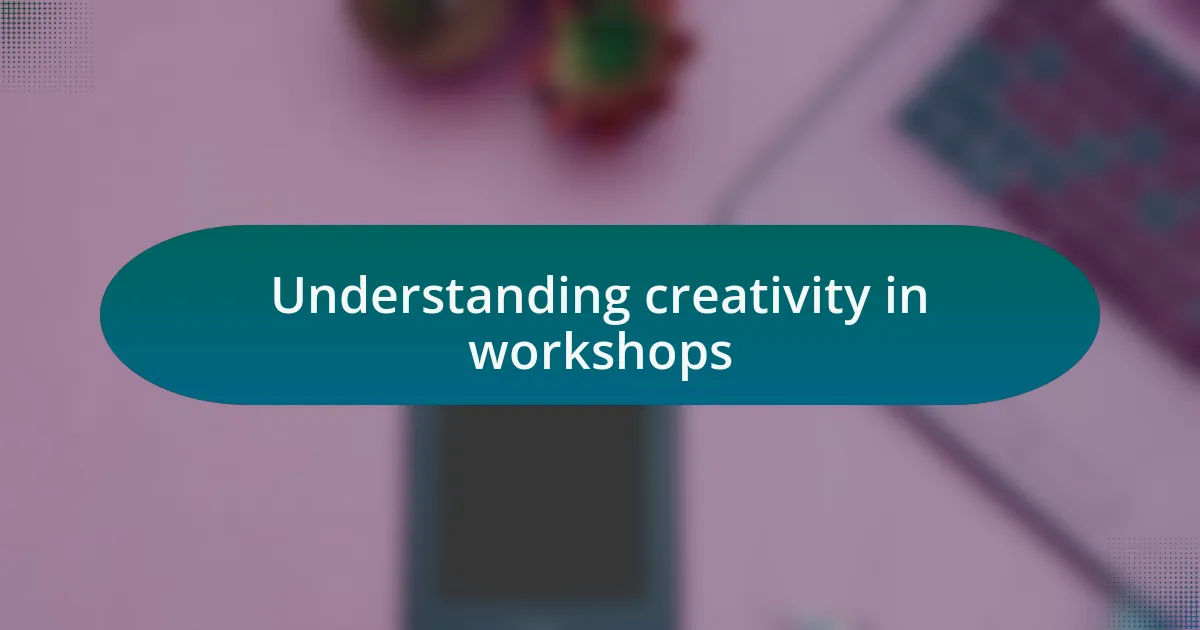
Understanding creativity in workshops
Creativity in workshops is often misunderstood as merely brainstorming sessions. From my experience, it’s really about creating an environment where participants feel safe to express their ideas freely. Remember the last time you hesitated to share a thought? That feeling can stifle creativity and prevent great ideas from surfacing.
I vividly recall a workshop where we began with an icebreaker designed to spark imagination. As we shared our wildest ideas without judgment, the group transformed. It was as if a weight had lifted, and I could sense the energy shifting. This openness laid the groundwork for more profound creative thinking.
What I’ve learned is that fostering creativity is about nurturing relationships and trust among participants. By encouraging collaboration, we allow diverse perspectives to shine, leading to richer solutions. Have you ever left a group discussion with an unexpected idea? That spark often comes from engaging with others, and that’s where the magic of creativity truly lies.
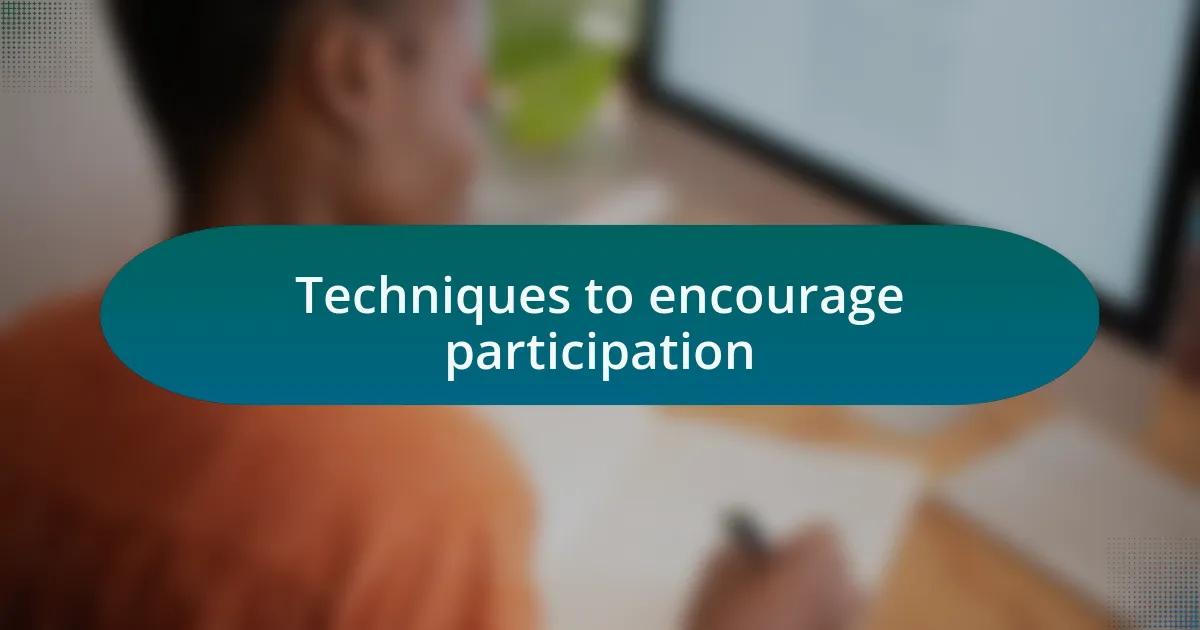
Techniques to encourage participation
To encourage participation in workshops, I often use structured activities that break the ice and help participants feel more engaged. For instance, during a recent session, we divided participants into small groups to tackle a common challenge. The result? Vibrant discussions filled with diverse opinions and the unmistakable sound of enthusiasm. It was a clear reminder that when people feel comfortable, they are more likely to contribute.
Another technique I’ve found effective is the use of visual prompts. In one workshop, I displayed images that sparked curiosity and discussion among participants. Watching them lean in, their eyes lighting up with ideas was incredibly rewarding. Have you noticed how a simple image can ignite a flurry of creativity? It’s fascinating to see how visuals can serve as a catalyst for deeper conversations.
Lastly, I make it a point to actively solicit input from quieter participants. During a technology workshop, I noticed one individual who had brilliant insights but seemed hesitant to share. By directly inviting them to speak, I unlocked a wealth of ideas that enriched the group discussion immensely. This taught me that ensuring everyone has a voice is crucial for fostering a collaborative spirit and maximizing creativity.
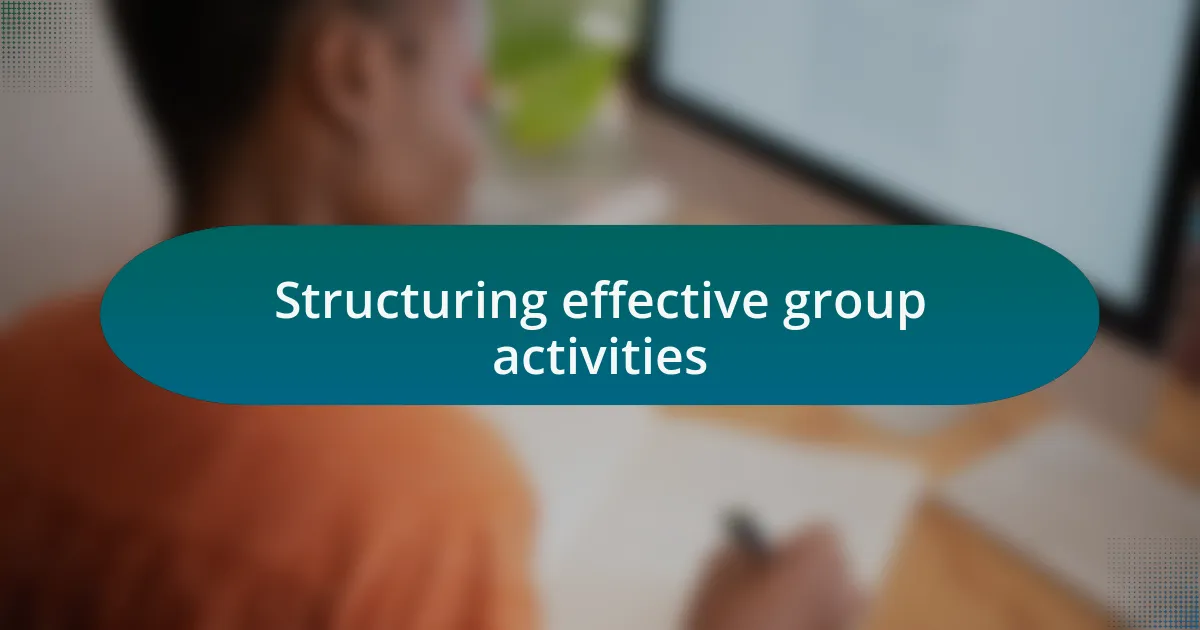
Structuring effective group activities
Designing effective group activities requires careful thought and intentional structure. One of my go-to strategies is to incorporate a mix of individual reflection and group brainstorming. I vividly recall a workshop where I first asked attendees to jot down their thoughts on sticky notes before sharing in their groups. This not only enabled quieter voices to emerge but also created a tangible framework for discussion. Have you noticed how seeing your ideas physically laid out can shift the dynamic of the conversation?
In structuring activities, I also prioritize diversity in roles within groups. Once, I assigned specific roles—like facilitator, note-taker, and timekeeper—to participants during a tech innovation workshop. This approach transformed the usual free-for-all discussions into organized, focused dialogues where everyone had a predefined purpose. It’s fascinating how simply defining roles can empower individuals and push the group’s creativity in unexpected directions.
Lastly, I find that integrating fun and unconventional elements can spark enthusiasm. At a recent coding workshop, I introduced a playful game element where teams had to create a mini-project under time constraints. Seeing the playful competitiveness emerge, I understood how stress could sometimes fuel creativity. Isn’t it intriguing how the right mixture of pressure and play can unlock a group’s potential?
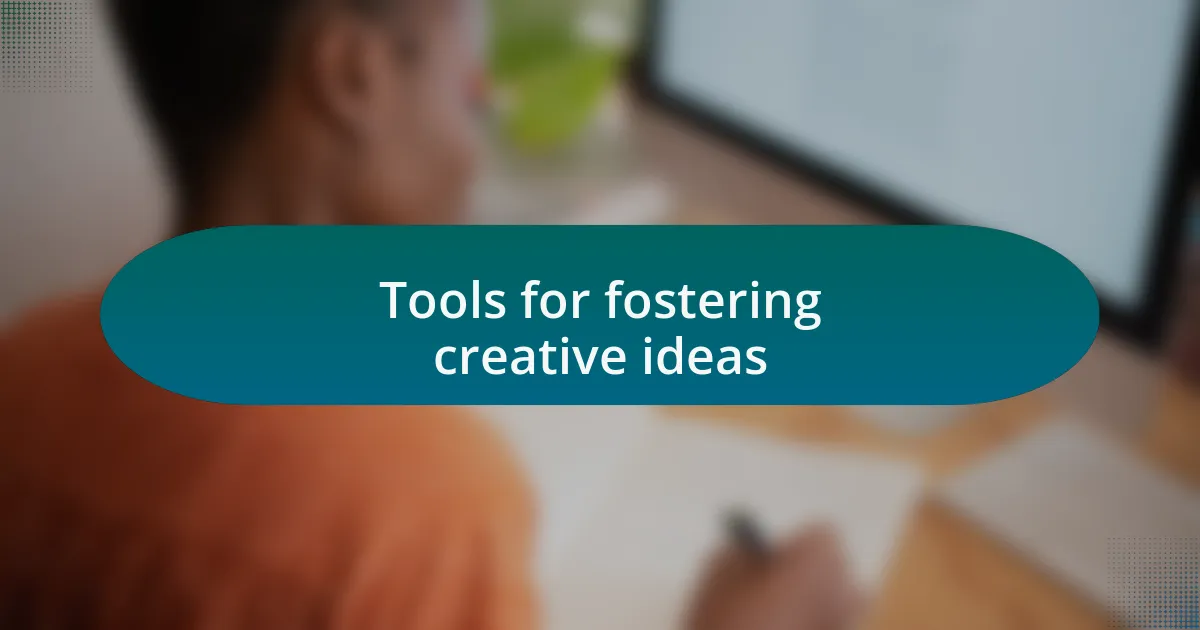
Tools for fostering creative ideas
When it comes to nurturing creativity in group workshops, I’ve found that utilizing digital collaboration tools can make a significant difference. During one of my recent tech meetups, we employed platforms like Miro and Trello to visualize ideas in real time. The excitement was palpable as participants could contribute, shift, and rearrange concepts on a digital canvas, making the brainstorming process feel dynamic and engaging. Have you ever felt that rush when seeing your thoughts take shape instantly?
Another effective tool I’ve come to appreciate is mind mapping software. I remember leading a session where we used MindMeister to explore a new product feature. The visual representation of ideas allowed participants to connect previously unlinked thoughts, sparking innovative solutions. It’s almost like watching the group’s collective consciousness expand in front of your eyes. How often do we overlook the power of visual aids in enhancing our creative processes?
Lastly, I can’t emphasize enough the role of feedback tools like Poll Everywhere or Slido in fostering creativity. During a workshop aimed at generating fresh marketing strategies, anonymous feedback from participants led to a safer space for sharing bold ideas. I was amazed at how much more freely people spoke once they knew their thoughts wouldn’t be judged on the spot. Isn’t it wonderful how creating a supportive environment can lead to groundbreaking ideas?
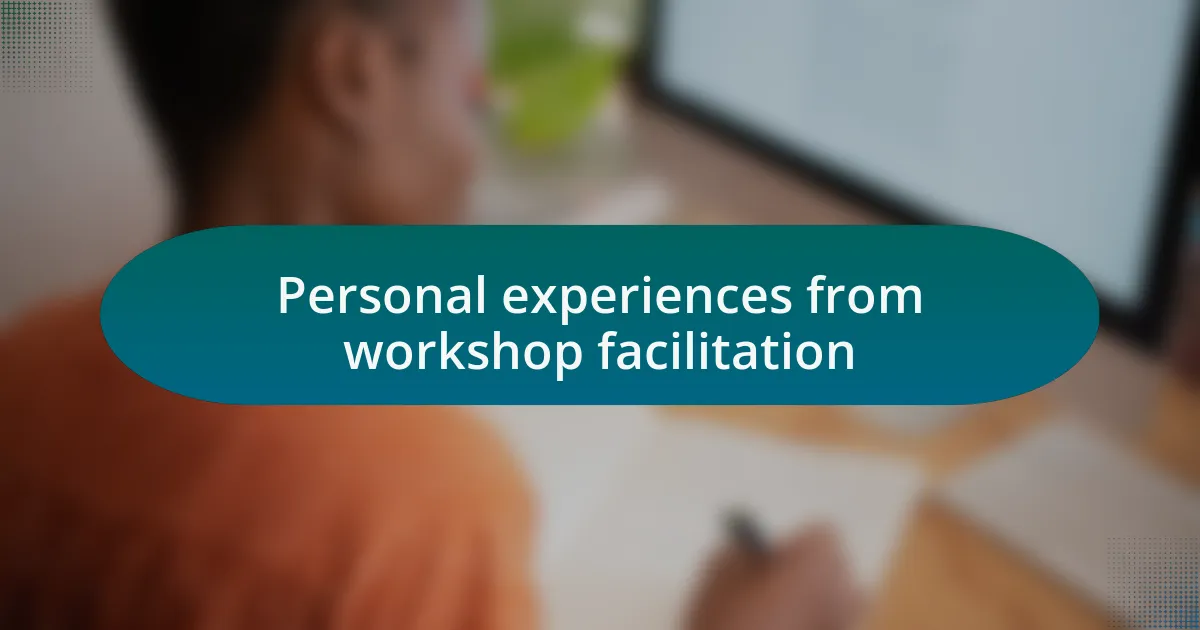
Personal experiences from workshop facilitation
Facilitating workshops has always been a fascinating journey for me. I recall one particular workshop where the energy shifted dramatically when I introduced an unconventional icebreaker—participants were asked to share their most unusual tech-related experiences. The storytelling aspect not only broke the ice but also laid the groundwork for open-mindedness. Have you noticed how sharing personal stories can strengthen connections within a group?
One memorable moment was during a design thinking workshop when I encouraged teams to prototype their ideas using craft materials. The initial hesitance slowly faded as laughter filled the room. The creative atmosphere allowed participants to let go of perfectionism, transforming abstract concepts into tangible, playful models. Isn’t it amazing how hands-on activities can awaken a childlike curiosity that fuels creativity?
I also find that setting up a “failure wall” in my workshops has transformative effects. In one session, I encouraged participants to share their past project mishaps and what they learned from them. The vulnerability displayed in that space fostered an environment where participants felt safe to take risks. I often wonder, how can we truly innovate without the freedom to fail?
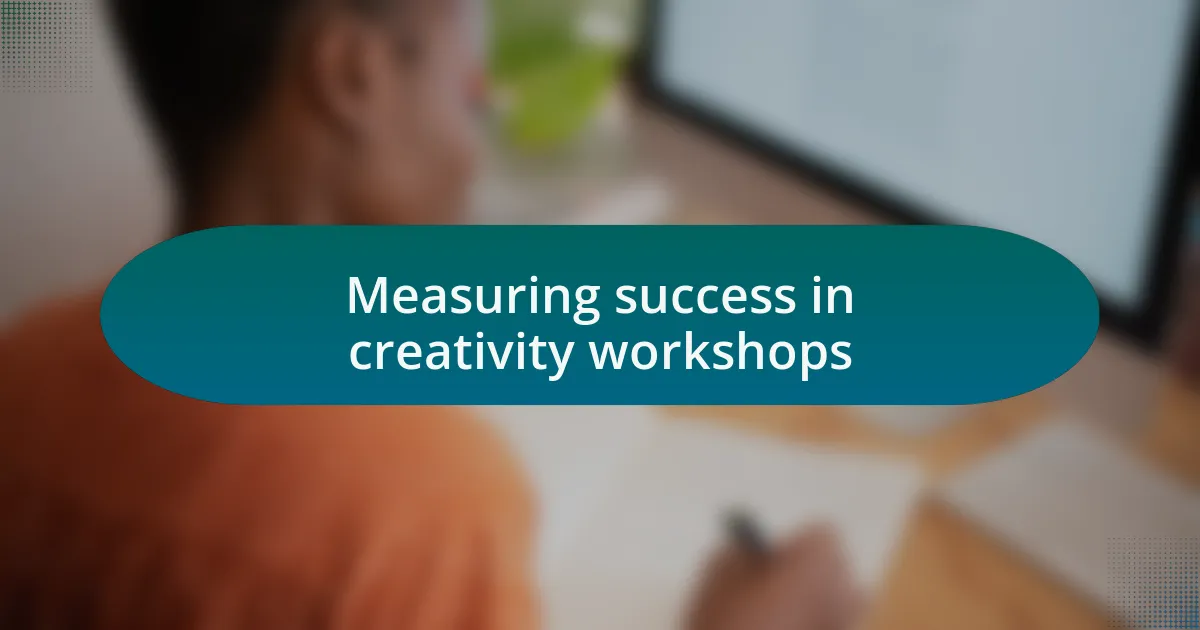
Measuring success in creativity workshops
Measuring success in creativity workshops can be multifaceted and personal. In one of my recent workshops, I asked participants to reflect silently after each session on what resonated with them most. This simple practice led to surprising insights—many discovered that their breakthroughs often stemmed from unexpected discussions or spontaneous moments of collaboration. Isn’t it enlightening to realize that success isn’t always quantifiable?
Another effective way I’ve gauged success is through feedback loops. After a session, I created a brief survey that encouraged participants to share not just what they learned but how they felt throughout the workshop. The emotional responses were incredibly telling; participants often reported feeling more connected and motivated to innovate. Could measuring emotional engagement be just as vital as tracking idea generation?
Lastly, I find observing the interactions during the workshop to be invaluable. Once, I noticed a team that initially struggled to communicate ideas openly suddenly clicked when they started building prototypes together. The shift in dynamics demonstrated that creative success often lies in the collaborative energy of the group rather than in mere outputs. How do we quantify that kind of synergy?